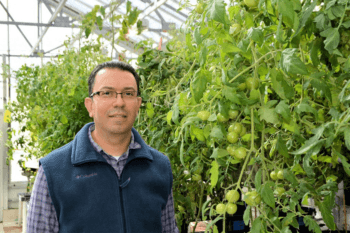Improved Tomatoes And Spinach Could Revive South Texas Production

The revival of the once thriving vegetable production industry in South Texas will begin with the development of new tomato and spinach varieties designed to perform well in the area’s harsh conditions, according to a Texas A&M AgriLife Research scientist.
Dr. Carlos Avila, a vegetable breeder at the Texas A&M AgriLife Research and Extension Center at Weslaco, said work has already begun to combine favorable traits from various tomato and spinach cultivars and germplasm.
Research began even before the ribbon-cutting ceremony in October to open Texas A&M AgriLife’s new Rio Grande Valley Vegetable and Education Building.
“In the case of tomatoes, production was nearly wiped out in the Rio Grande Valley by insects and diseases that were not around in the 1960s and 70s when production was thriving here,” Avila said.
Production dropped from 36,000 acres to only about 800 acres today, he said. Texas is now a net importer of about 2.4 billion pounds of tomatoes annually.
John Sharp, Texas A&M University System chancellor, who led the ribbon-cutting ceremony, said, “Being a net importer of vegetables is not only unacceptable, it’s un-Texan.”
Avila said the biggest complaints from consumers are that imported tomatoes just don’t taste as good as they used to.
“That’s because tomatoes shipped to the U.S. from Mexico, for example, have to be picked green in order to extend their shelf life,” he said.
“We just have more pests and diseases here than California and Florida where tomato production has not decreased. High temperatures here also decrease yields. So, a lack of adequate cultivars and cropping practices, plus emerging production areas like Mexico, whose government subsidizes production, has created the need to reestablish production here.”
Continue reading on AgriLife Today.
This article by Rod Santa Ana originally appeared in Texas A&M AgriLife Today.





